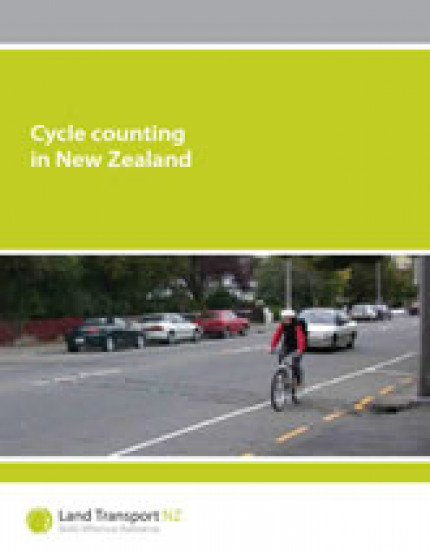
This literature review explores the merits, limitations and costs of seven main types of technology available for counting bicycle traffic on a continuous basis. For the purposes of this report, ‘continuous’ means for several months or more. The technologies investigated were:
All prices quoted are for New Zealand dollars, exclusive of GST (as of October 2007).
These use lenses that detect radiation emitted by people and animals. By placing two detectors along a path, information can be obtained on the speed and direction of travel. However, the detectors cannot distinguish between mode types.
Several trials of passive infrared detectors have been documented (Schneider et al 2005, Thé 2007). In all cases, the studies counted pedestrian and bicycle numbers on shared-use, off-road paths, as infrared counters were deemed inappropriate for mixed-traffic situations. Infrared counters are able to gather data for long observation periods in all weather conditions. However, in many studies, the devices also counted animals and, occasionally, falling leaves. In some cases, the infrared counter could not distinguish between one and two people.
Many surveyors deemed it necessary to supplement the automatic counts with manual survey information to distinguish between cyclists and pedestrians and provide demographic characteristics, such as age, gender and reason for travel.
Eco-Counter(external link) manufactures several passive infrared detectors (they are known as ‘pyroelectric sensors’). The devices can operate at a range of up to 4 m and come with a data logger that has a battery life of approximately 10 years. A unit costs approximately $3700.
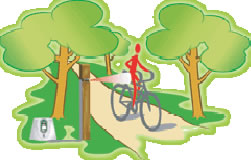
Figure 1 - How passive infrared detectors like
Eco-Counter's Pyroelectric Sensor work
These emit one or more beams of infrared radiation (that may scan back and forth along a line) and detect when the beams are obstructed. As with passive infrared detectors, information can be obtained on speed and direction. In addition, however, special algorithms can be used to infer the type of mode detected.
One trial used the active infrared device Autosense II to detect cyclists and pedestrians on a shared-use path. Noyce, Gajendran and Dharmaraju (Noyce et al 2006) developed an algorithm that could be used with Autosense II that detected cyclists and pedestrians 100 percent of the time, with 92 percent accuracy for distinguishing between the two. The algorithm had a good accuracy even when multiple cyclists passed at once.
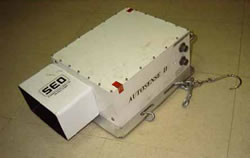
Figure 2 - Autosense II
This illustrates that it is possible to achieve good results using active infrared devices. The algorithm developed was intended to distinguish between pedestrians and cyclists and would need to be modified for the cyclist versus motor traffic situation. It has also been noted (Schneider et al 2005) that, as the Autosense II was designed for motor traffic situations, it would classify bicycles as motorcycles. The software would need to be revised if applied in situations where both bicycles and motorcycles would be present.
Unfortunately, the algorithm was developed as research and does not appear to be commercially available; also, it seems Schwartz Electro Optics, the company that developed the Autosense II, declared bankruptcy in 2003. Similar products have not been identified.
TIRTL (The Infra-Red Traffic Logger), manufactured by CEOS(external link), is another active infrared counter that can determine vehicle types, directions and speeds.
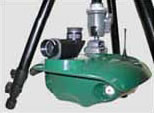
Figure 3 - TIRTL
Also, because the TIRTL has four infrared beams, two straight and two crossed (as shown in figure 4), it is able to measure a vehicle's position across the roadway and hence determine which lane it is in.

Figure 4 - TIRTL beams
Russell Kean from Opus's Central Laboratory in Lower Hutt has been using a TIRTL for several years. He reports a 98 percent accuracy (compared to the 99 percent accuracy claimed by the manufacturers) for classifying motor vehicles in dry conditions and states that the TIRTL does not perform as well in wet weather. In mixed-traffic situations, the TIRTL only correctly classified bicycles (as 'vehicles under 1 m') about 50 percent of the time. However, Opus was not focusing on counting bicycles and states that it may be possible to program a more reliable classification process to increase the TIRTL's accuracy for counting bicycles. This would involve further research and testing. Also, according to Macbeth and Weeds (2002), bicycles typically have wheelbases of between 1.0 m and 1.1 m, so the TIRTL's default settings would not be appropriate for detecting bicycles.
The TIRTL is available at around $23,400 and can be powered either by a 12 volt battery (which provides power for two to three weeks) or through an external power supply. The TIRTL's data logger can store up to 30 million vehicle records.
These emit radio waves and detect travellers when the beams are broken.
By using two radio frequencies, it is possible to distinguish between pedestrians and cyclists on shared-use paths. However, such systems are not generally able to provide information on cyclist speed and direction – to do so would require two detectors and additional software development.
No documentation on radio beam detectors was found in the literature review, but personal correspondence with the Queenstown Lakes District Council revealed that they have two radio beam counters installed on shared-use paths. The engineer in charge of the counters stated that they were the best technology he had found in his 20-year experience using counters.

Figure 5 - Location of the radio beam
bicycle counter used by the Queenstown
Lakes District Council
Chambers Electronics(external link) manufactures the Radio Beam Bike and People Counter used by the Queenstown Lakes District Council.

Figure 6 - Chambers Electronics' Bike and
People Counter
This device operates at a range of up to 3.5 m and uses a 12 volt battery that operates for 100 days before charging is required. The total cost of the counter, two batteries, a battery charger, mounting posts, loggers and computer software is approximately $7500.
These are made from piezoelectric material, which is buried underground and detects changes in pressure when bicycles are ridden over the surface.
Pressure counters are the least visible of all counting technologies. Dual systems can be used to infer the speed and direction of travel, and algorithms can be developed to distinguish between cyclists and pedestrians. The United Kingdom's Department of the Environment Traffic and the Regions uses some piezoelectric counters for continuous monitoring. They stated 95 percent accuracy but acknowledged that, in mixed-traffic situations, the presence of motor vehicles significantly reduces their accuracy.
In one American trial (Schneider et al 2005), piezo-film counters were used with algorithms aimed at distinguishing bicycles from pedestrians on shared-use paths. It was acknowledged that occasionally non-bicycle objects were recorded as bicycles. The trial identified one of piezo-film's advantages as being that it is much less conspicuous over infrared devices. One instance was noted where concerned residents noticed the infrared device and informed the police, who called the bomb-squad and had it destroyed. Piezo-film was not identified as being more accurate than other devices.
MetroCount(external link) manufactures piezoelectric underground pressure counters. No information from existing users in New Zealand or Australia has been found.

Figure 7 - How pressure counters like MetroCount's 5710 Piezo-Counter work
The MetroCount 5710 system costs approximately $5800, with significant discounts per unit for bulk purchases. It has a battery life and data storage capability of around 290 days (or longer in lower-flow conditions).
Pneumatic tubes, often known as ‘rubber tubes’, are currently the most common device for automatically counting cycle traffic. The pressure counter is laid on the ground and detects changes in air pressure when the tubes are compacted.
Pneumatic tubes will only detect pedestrians if they step directly on the tube so it is not advisable to use them in situations where pedestrians are present, as some will be detected (but possibly recorded as other modes) and others not. However, when two tubes are used in conjunction with algorithms that can distinguish between bicycles and motor vehicles, they do work in mixed-traffic situations and can classify traffic and determine speed and direction.
A New Zealand study (Macbeth and Weeds 2002) showed that pneumatic tubes are appropriate for use on New Zealand roads and, at the time, were more accurate than inductive loops for distinguishing between bicycles and motor vehicles. When the MetroCount 5600 system was used on a site with a 5 m tube length, it accurately counted 50 cyclists. However, when the tube length was increased to 10 m (to include motor vehicle counts), the accuracy decreased to 86 percent. The Golden River Marksman 410 system was shown to be more accurate because of its longer tubes, having a 96 percent accuracy for three different count sites with a combined sample size of 427 cyclists.
It was noted that cyclists who rode on footpaths would not be recorded by pneumatic tube counters installed on the roads, unless counter tubes were also installed across the footpath. Also, false detection would occur when bicycles and motor vehicles passed over the tubes simultaneously. The tube counters were generally less accurate in urban situations than semi-rural situations.
A more recent New Zealand study (Macbeth 2007), with a much larger sample size than the first, identified many problems that occurred when using the MetroCount tube system to count on-road cyclists:
When the MetroCount data for five on-road sites (both sides of each road) were compared with manual counts taken over the same survey period, the MetroCount system was 62 percent accurate (the sites ranged in accuracy from 14 percent to 100 percent). A similar investigation for four off-road sites yielded an accuracy of 85 percent (ranging from 74 percent to 100 percent). It was identified that site selection and placement of tubes are important factors in determining the accuracy of the MetroCount pneumatic tube system.
Appendix 1 contains a guide to selecting sites suitable for cycle counting using MetroCount tubes and to placing the tubes.
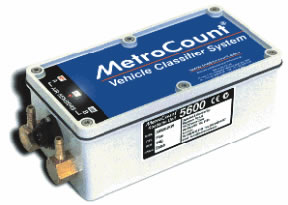
Figure 8 - MetroCount 5600
The MetroCount 5600 system costs approximately $3000, with significant discounts per unit for bulk purchases. It has a battery life and data storage capability of around 290 days (or longer in lower-flow conditions).
Several other manufacturers produce pneumatic tube counters; however, as MetroCount is the most common in New Zealand, other manufacturers have not been researched further.
Although little documentation on the sturdiness of pneumatic tubes was found, anecdotal evidence suggests that they are very susceptible to wear and tear from traffic and are not appropriate for permanent counting. Tubes may become worn or broken and result in the loss (or decreased accuracy) of data. There is no way of remotely determining when this occurs. Also, because pneumatic tubes and counters are situated above the ground surface, they can be vandalised.
This involves recording the traffic with a video camera and determining the presence of cyclists or other mode users, either manually or with a computer.
Video-image processes can be used to determine cyclists' speeds, directions and positioning across the roadway.
Fowler and Koorey (2006) used video recording to monitor cyclists' direction and positioning, with the aid of painted marks across the road. Recordings were processed manually after surveying. Skilton (2007) used a similar process involving still photographs. Both groups of researchers found that the process was very time intensive (as they were required to be present during the recordings and later in the analysis of the images). However, a very positive outcome was that they could also gain insights into the behaviour of cyclists and characteristics such as their age, gender and ability that was not available from ‘blind’ technologies.
The Christchurch City Council has experimented with video technology at wide intersections where there had been a problem with cyclists beginning to cross the intersection at the end of the green phase and not having enough time to reach the other side of the intersection before the start of the opposing traffic's green phase. The aim was that, when a cyclist was present in the intersection during the inter-green time, the video camera would detect a pixel disturbance and delay the beginning of the opposing traffic's green phase. However, other things, such as pedestrians or cars turning through the intersection, also created pixel disturbances. This resulted in the longer green phase being used when it was not necessary and hence too much wasted time and a decrease in the intersection's efficiency. The Christchurch City Council no longer uses video technology for this purpose.
While this was not intended to count cyclists but to detect them, the process used and the information obtained could easily be used for counting cyclists.
Autoscope manufactures several video imaging products.
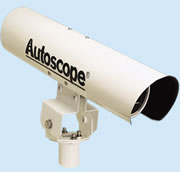
Figure 9 - Autoscope's Solo Terra
Autoscope counts vehicles passing through a pre-defined ‘detector zone’; thus, it could be used to count cycles travelling on a cycle lane. However, there would be errors when cyclists rode side by side, when cyclists avoided the cycle lane or when vehicles and pedestrians entered into the cycle lane.
In addition to the Solo Terra camera, a processing unit is required; the combined cost is approximately $9500 (based on a minimum purchase of 10 units).
These are wires laid in the ground that experience electro-magnetic induction when metal objects (such as motor vehicles and most bicycles) pass over them.
Inductive loops are used extensively in New Zealand for detecting motor vehicles so that SCATS (Sydney Coordinated Adaptive Traffic System) can control signal timings. The Christchurch City Council obtains cycle traffic information from SCATS inductive loops where shared use pedestrian and cycle paths have signalised road crossings. These data are not routinely used for cycle monitoring, however.
The council has also trialled inductive loops to detect cyclists crossing signalised road intersections at the end of a green phase. Similar problems to those of the video imaging technology were noted. The loops would not distinguish between cyclists and motor vehicles. Also, placement of the loops was difficult as cyclists do not always ride in the same place through an intersection.
The Bicycle Recorder manufactured by Counters and Accessories(external link) is an inductive loop detector commonly used for counting cycle lane traffic in South Australia. One user said they had achieved high success rates with the device, even when two cyclists rode side by side. When tested, the device did not record shopping trolleys, prams or other metal objects. Counters and Accessories identified a 95 percent accuracy in a study where they had chosen the site; no additional information was available regarding this study.
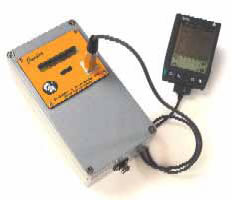
Figure 10 - Bicycle Recorder by Counters and Accessories
The Bicycle Recorder can be powered by mains or solar power and can be fitted with a GSM modem, which allows remote data download. The total cost of such a system is approximately $5000.
Eco-Counter's ZELT inductive loop sensor system claims to be able to detect the characteristic electro-magnetic signature of bicycles and distinguish them from motor vehicles. The French Government Transportation Research Lab found a ±5 percent accuracy for the ZELT when used in mixed-traffic situations. In a study, 91 percent of bicycles (156 out of 171) were correctly detected, 6 percent of motorcycles (7 out of 120) were incorrectly classified as bicycles and no other motor vehicles were classified as bicycles.
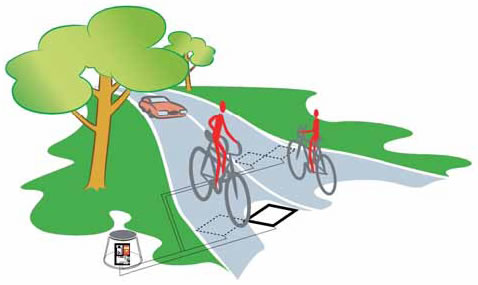
Figure 11 - How Eco-Counter's ZELT inductive loop sensor system works
ZELT can work for a lane width of up to 3 m; considering that most cycle lanes are well below this and that cyclists ride to the side of shared traffic lanes, this width should be sufficient. The logger uses two 3.6 volt batteries that have a lifetime of one year and are cheap to replace (or can be recharged).
For a situation where bicycles are to be detected beside or among motor vehicles, the cost of the ZELT detectors, logger and software would be approximately $2900 (or $4000 if speed and direction information were required). Installation costs would be additional.
The ZELT and Bicycle Recorder systems are different to inductive loops already in use as they use specialised algorithms and loop patterns to detect bicycles accurately. It would be possible to modify current loops used (eg for SCATS) but this would require research and the development of new algorithms.
Inductive loops will not detect bicycles made from non-metallic materials, such as carbon fibre. This issue is not yet sufficiently significant to prevent the use of induction loops, but the increasing trend for carbon-fibre bicycles may affect the reliability of inductive loop counting in the future. Most counters claim an accuracy of about +5 percent, so a small proportion of carbon-fibre cycles would not introduce excessive errors.
Another limitation is that inductive loop counters installed on a road will not count cyclists riding on an adjacent footpath, so counting cyclists on a road where there also happens to be a significant amount of footpath cycling would introduce errors (unless additional loops were installed on the footpath). They also do not detect pedestrians.
Table 1 - Characteristics of counters [PDF, 47 KB] (PDF, 38 KB)
All of the products that were reviewed count cycles but many are also able to:
Most counters range in price from $3000 to $10,000. Installation costs would be additional to this.
From this limited literature review, the inductive loop products (Counters and Accessories' Bicycle Recorder and Eco-Counter's ZELT) appear to be the best for counting both on-road and off-road cycle traffic.
Accordingly, it would be useful to test these two counters in New Zealand. As a number of key personnel are based in Christchurch and some sites already exist with inductive loops installed, it would be logical to undertake a pilot project in Christchurch. It is understood that Glen Koorey at the University of Canterbury has a video recorder and would be interested in collaborating with this pilot. It may also be beneficial to collaborate with Opus International Consultants Ltd, which is currently working on a research project on pedestrian counters.
If pedestrian counts are also required, it would be advisable to consider Eco-Counter's Pyroelectric Sensor or Chambers Electronics' Bike and People Counter. Video technology could also be considered.
It is recommended that Land Transport NZ:
Fowler, ML and GF Koorey (2006) The effect of the Pages Road cycle lane installation on cyclists' safety and traffic flow operation, IPENZ Transportation Group Conference, Queenstown, http://viastrada.co.nz/sites/viastrada/files/pages-cycle-lanes.pdf(external link).
Macbeth, AG (2007) Development of a cycle traffic AADT tool, ViaStrada Ltd, Christchurch.
Macbeth, AG and MG Weeds (2002) Evaluation of automatic bicycle counters in New Zealand, Transfund research report no. 230, MWH New Zealand, Christchurch.
Noyce, DA, A Gajendra and R Dharmaraju (2006) Development of a bicycle and pedestrian detection and classification algorithm for active-infrared overhead vehicle imaging sensors, University of Wisconsin-Madison, Washington DC.
Schneider, R, R Patton, J Toole and C Raborn (2005) Pedestrian and bicycle data collection in United States communities – quantifying use, surveying users and documenting facility extent, University of North Carolina, Chapel Hill.
Skilton, L (2007) Effect of colouring a cycle lane, IPENZ Transportation Conference, Tauranga, www.hardingconsultants.co.nz(external link).
Thé, R (2007) Expansion of the Bicycle Count Program, City of Vancouver, Vancouver.